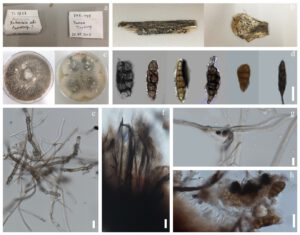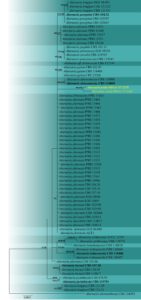Alternaria arida Chaiwan, Jayawardena, Bulgakov & K.D. Hyde, sp. nov.
Index Fungorum number: IF 900631; Facesoffungi number: FoF 15188; Fig. 1
Saprobic on dead stems of Artemisia absinthium. Sexual morph: Undetermined. Asexual morph: Conidiophores 10‒60 × 4‒6 μm (x̅ = 35 × 5 μm, n = 30), solitary or terminally erecting from hyphae, straight or slightly curved, pale brown to brown, 1‒5-septate, rough, usually with virgariella-like branching patterns. Conidia 20‒40 × 10‒20 μm (x̅ = 30 × 15 μm, n = 50), solitary, occasionally 2 in a chain, long ovoid and ellipsoid, erostrate, light brown to dark brown, smooth-walled, 3‒6 transverse septa (sometimes up to 7), 0‒2 longitudinal septa or oblique in a transverse segment.
Culture characteristics – Colonies on PDA reaching 30.5 mm diam. after 14 days at 25 ºC, covering petri dish in 4 weeks, initially white to gray, circular, flat, slightly wooly, entire margin. Sporulating regions at the centre.
Material examined – Russia, Rostov region, Rostov-on-Don City, Botanical Garden of Southern Federal University, ruderal vegetation, on dead stems of Artemisia absinthium, 11 May 2017, Timur S. Bulgakov, T-1833 (MFLU 17-2135, holotype); Russia, Donetsk region, Donetsk, Donetsk Botanical Garden, on dead leaves of Yucca filamentosa, 20 May 2017, Timur S. Bulgakov, DNK-140 (MFLU 17-2561).
GenBank accession numbers – MFLU 17-2561 – ITS: OR135245, gapdh: OR140522, tef1-α: OR140524; MFLU 17-2135 – ITS: OR135247, gapdh: OR140523, tef1-α: OR140525.
Notes – Based on our phylogenetic analysis of combined ITS, gapdh, rpb2, tef1-α, and Alt-a sequence data of Alternaria species (Fig. 2), our isolates (MFLU 17-2135 and MFLU 17-2561) clustered with 99% maximum parsimony, 95% maximum likelihood bootstrap support and 1.00 Bayesian posterior probability, confirming that they belong to the same species. However, in the phylogenetic tree, these two isolates formed a branch separated from other Alternaria species (Fig. 2). Consistent with the multi-gene phylogenies, this phylogenetically distant group also shows different morphologies compared to the closely related A. alstroemeriae (Fig. 1). Our species differs from A. alstroemeriae by having smaller conidia (20‒40 × 10‒20 μm), solitary, pale to medium brown, narrowly ellipsoid to ellipsoid or ovoid, beakless conidia with multiple transverse septa and rarely longitudinal septa, while A. alstroemeriae subcylindrical conidia in short chains (Simmons 2007, Yamagishi et al. 2009, Nishikawa & Nakashima 2013). Furthermore, chalastospora and branched primary conidiophores were not observed in our species compared to A. alstroemeriae (Woudenberg et al. 2013, Kgatle et al. 2018). Furthermore, our species are slow-growing on PDA, reaching 30.5 mm diam. at 25 ºC after 14 days with white to grey colour colonies and the sporulation can be mostly observed at the center while colonies of A. alstroemeriae grows faster (covering petri dish after 7 days at 25 ºC), and sporulation is submerged in agar substrates (Simmons 2007). The mycelial growth on PDA are olivaceous brown to black (Yamagishi et al. 2009).

Fig. 1 – Alternaria arida (MFLU 17-2135, holotype). a The specimens in the envelop. b Appearance of ectostromata on host surface. c Culture on the PDA. d Conidia. e–g Conidiophores. h Conidia and conidiophores. Scale bars: d, e, f, h = 10 μm, h = 5 μm.

Fig. 2 – Phylogram generated from maximum likelihood analysis based on combined LSU, SSU, ITS, gadph and tef1-α sequence data for Alternaria taxa, comprising 1,341 characters (ITS = 522, gadph = 579, and tef1-α = 240). The best-scoring RAxML tree with a final likelihood value of -5250.975025 is presented. The matrix had 146 distinct alignment patterns, with 4.65% of undetermined characters or gaps. Evolutionary model applied for all genes is GTR+I+G. Bootstrap support values for maximum likelihood (ML) equal to or greater than 70% and posterior probability values greater than 0.90 are given at each node. Ex-type strains are in bold, while the new isolate is indicated in yellow. The tree is rooted to Alternaria alternantherae (CBS 124392).
